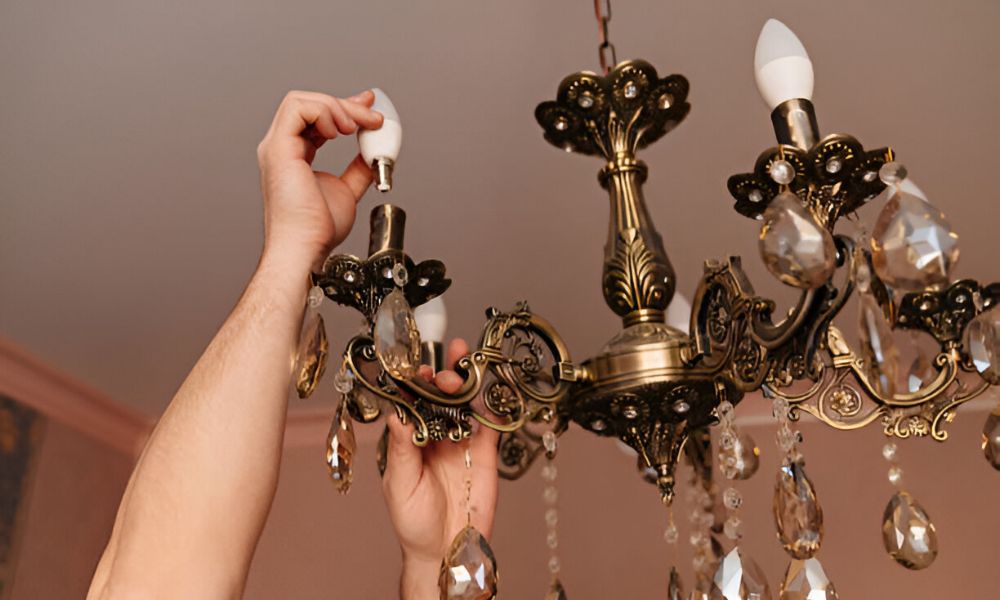Last week, I had how to change chandelier light bulbs in high places. It was harder than I thought. My ladder wobbled. My hands shook. I didn’t feel safe at all. I almost gave up until I found the best light bulb changer for high ceilings. Now I know how to remove a light bulb from a high ceiling—without stress or risk. In this post, I’ll show you how to do it the easy way.
Why Changing Chandelier Bulbs in High Places Feels So Tricky
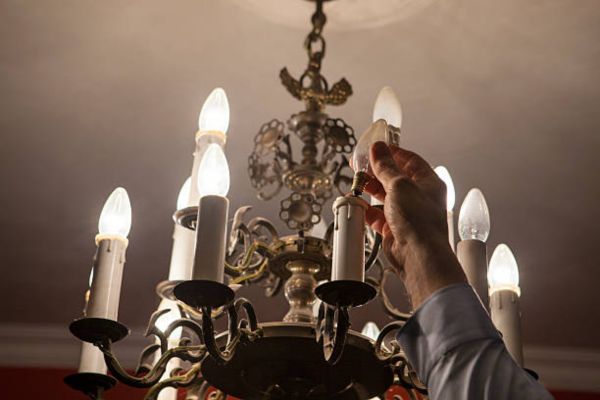
Changing a light bulb sounds easy, right? Not when it’s high above your head. Changing chandelier bulbs in high places is hard because they’re high, fragile, and often out of reach.
Even with a ladder, things don’t feel safe. Your hands shake. The ladder may move. And if the bulb is glass, you worry it might fall and break.
Some chandeliers use odd-shaped bulbs. They can be long, small, or smooth. That makes them hard to grip. One slip, and the bulb could crack.
I still remember my first try. I looked up, climbed halfway, and froze. It felt scary. I had no grip, and no plan.
Don’t worry. You’re not alone. Lots of people face the same issue. But with the right tools, it gets much easier.
Tools That Make the Job Easier
Best Light Bulb Changer for High Ceilings
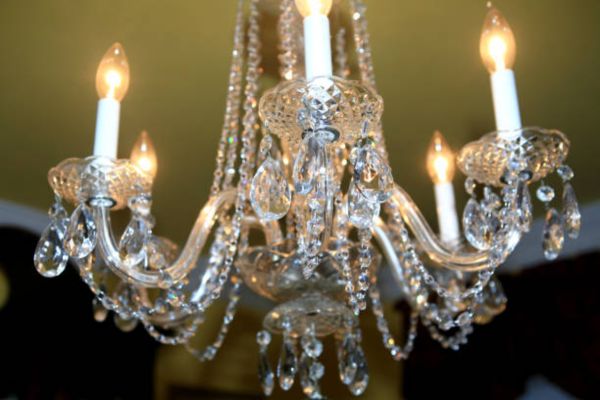
When I first saw a light bulb changer pole, I honestly thought it looked like a toy. But it changed everything. These tools come with a long pole and a soft grip at the top—either a suction cup or a claw. You stick it up, twist the bulb out, and you’re done. No ladder. No stress.
The suction cup works best for round, flat bulbs. The claw style grips odd shapes like candle or cone bulbs. Both types are great, but not perfect. Suction cups sometimes slip on dusty bulbs. Claws might not hold tightly if the bulb is very smooth.
I bought mine after freezing on a ladder one too many times. I searched online for the best light bulb changer for high ceilings, read the reviews, and ordered it. The first time I used it, I changed the bulb in under a minute—and I didn’t even break a sweat.
Step-by-Step Guide: How to Remove a Light Bulb from a High Ceiling
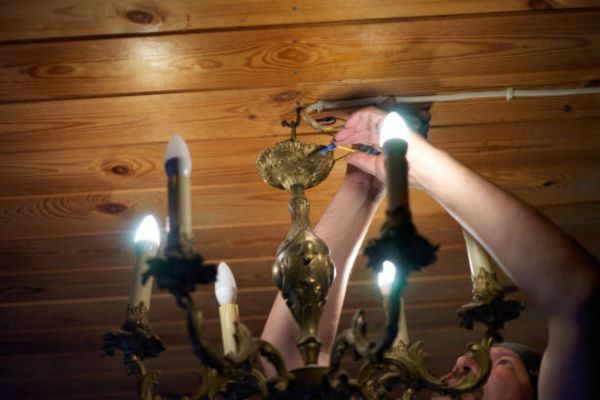
Removing a bulb up high may seem scary at first, but with the right steps, it’s quick and safe. Here’s exactly what I do every time.
Step 1: Turn off the power
Before anything, flip the switch off—or better yet, shut off the breaker. It’s the easiest way to stay safe from shocks.
Step 2: Choose your method
If the ceiling is under 12 feet, I use a ladder. For anything taller, I grab my pole-style light bulb changer. Scaffolding? Only if it’s way out of reach or over stairs.
Step 3: Position yourself securely
If I’m on a ladder, I check the floor. No wobbles. I stay centered. If I’m using a pole, I stand right below the bulb and look straight up.
Step 4: Use the right tool
A suction cup works great for smooth, round bulbs. I press and twist gently. For candle or cone bulbs, the claw grip holds better.
Step 5: Twist slowly
Turn the bulb to the left. Don’t rush. I keep my hand steady and watch for any movement in the fixture.
Step 6: Check the new bulb
This part saved me many trips: I always test the new bulb on the ground first to make sure it works. It’s simple and saves time.
Step 7: Install the new one
I screw it in slowly—just enough to hold firm, not too tight. Overtightening can crack the base or make the next removal harder.
And that’s it! One light changed, no drama, no broken bulbs, no second trip up the ladder.
Pro Tips for Choosing the Right Replacement Bulb

Once you’ve removed the old bulb, don’t just grab any replacement. The right bulb makes all the difference—both in how your chandelier looks and how it lights up your space.
Match the wattage and style
Always check the old bulb before buying a new one. Look for the wattage and the base size. Chandeliers often use smaller bases like E12. If your fixture had an incandescent, you can switch to an LED version for the same look but with less heat and more life.
Pick the right light color.
For cozy rooms, I go with warm light (2700K–3000K). It feels soft and welcoming. For kitchens or bright spaces, cool white (4000K–5000K) is sharper and better for focus.
Go LED for energy and peace of mind.
I switched to long-lasting LED chandelier bulbs years ago. They use less power and last 10x longer than old-school ones. That means fewer trips up the ladder—which I truly love.
Don’t forget dimmable bulbs.
If your chandelier is on a dimmer switch, make sure the new bulb says “dimmable” on the box. I learned this the hard way—non-dimmable LEDs flicker or buzz when dimmed. It’s a small detail that makes a big difference.
Safety First – Avoiding Common Mistakes
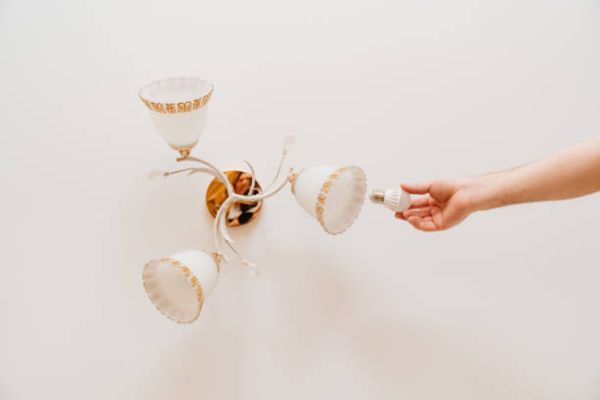
When changing chandelier bulbs in high places, it’s easy to rush. But small mistakes can lead to big problems. Trust me, I’ve learned the hard way.
Don’t stand on furniture.
It might seem faster, but a chair or table isn’t built for climbing. One small wobble, and you’re on the floor. Always use a proper ladder—it’s safer and gives you better balance.
Turn off the switch (or breaker).
Yes, even for bulbs. I once forgot and got a tiny shock. It woke me up faster than coffee. Play it safe—flip that switch or shut off the breaker before you touch anything.
Avoid overtightening.
When installing the new bulb, twist just enough to hold it in place. Don’t force it. I’ve cracked bulbs before by going too far—and it’s harder to remove them later.
Check the ladder’s weight limit.
Ladders come with weight ratings for a reason. If you’re carrying tools or stretching too far, you might exceed it without knowing. I always check the label now—just to be sure.
My near-fall story.
Once, I tried to change a bulb while leaning to the side on a ladder. I felt it tip. I caught myself, but it shook me. That day taught me to keep both feet centered and never rush.
When to Call a Professional
Sometimes, it’s smarter—and safer—to let an expert handle it. Not every bulb is worth the risk, especially when things get tricky.
Super high ceilings? Let it go.
If your ceiling is 20 feet or more, don’t risk it. Even with tall ladders or poles, it’s hard to work that high. One wrong move could lead to a fall. I once tried to DIY a tall fixture—and after one shaky climb, I called an electrician.
Antique or fragile chandeliers need extra care.
Some chandeliers are heavy, delicate, or full of tiny glass parts. One wrong bump can ruin them. A professional knows how to handle those with care. It’s better than breaking a family heirloom.
Need to fix wires or parts?
If the bulb won’t work even after changing it, the issue might be deeper. Loose wires, faulty sockets, or flickering lights could mean it’s time for fixture maintenance. Don’t guess—get help.
Think of your peace of mind.
Sure, pros cost money—but what’s your safety worth? I’ve found that paying once for a safe job beats worrying for days.
FAQs
What is the safest way to change a light bulb on a high ceiling?
The safest way is to turn off the power first and use a secure ladder or a light bulb changer pole. Avoid standing on chairs or unstable surfaces. Always follow the 3-point contact rule when using a ladder.
Can I use a light bulb changer pole for all chandelier bulbs?
You can use a bulb changer pole for most chandelier bulbs, especially smooth or standard-shaped ones. For odd-shaped or tight bulbs, a claw-style attachment works better than a suction cup.
What’s the best light bulb changer for high ceilings?
The best bulb changer for high ceilings is one with a telescoping pole and interchangeable heads—like suction cups and claws. Look for models with a long reach and soft grips for better control.
How do I remove a stuck bulb from a high chandelier?
First, turn off the power. Use a pole with a strong grip or carefully climb a ladder if needed. Twist gently to avoid breaking the bulb. If it’s still stuck, wrap it with rubber for better grip or call a pro.
Should I switch to LED bulbs for chandeliers?
Yes, LED bulbs last longer, use less energy, and give off less heat. They’re great for chandeliers because they reduce how often you need to change bulbs—especially in high places.
Conclusion
Changing chandelier bulbs in high places may seem tough at first—but with the right tools and a little care, it’s something anyone can do. You don’t need to be an expert. You just need to be safe and smart.
What I’ve learned over the years is simple: safety comes first. A good grip, a steady ladder, and the right bulb make all the difference. And once you’ve done it a few times, it stops feeling scary.
Now, changing my chandelier bulbs feels like a quick weekend task instead of a dreaded chore. No stress, no drama—just one more thing checked off the list.

